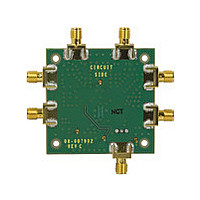AD8349-EVAL Analog Devices Inc, AD8349-EVAL Datasheet - Page 20

AD8349-EVAL
Manufacturer Part Number
AD8349-EVAL
Description
Manufacturer
Analog Devices Inc
Datasheet
1.AD8349-EVAL.pdf
(28 pages)
Specifications of AD8349-EVAL
Lead Free Status / Rohs Status
Not Compliant
AD8349
SIDEBAND SUPPRESSION AND LO FEEDTHROUGH
VS. TEMPERATURE
In practical applications, reduction of LO feedthrough and
undesired sideband suppression can be performed as a one time
calibration, with the required correction factors being stored in
nonvolatile RAM. These compensation schemes hold up well
over temperature. Figure 40 and Figure 41 show the variation in
LO feedthrough and sideband suppression over temperature
after compensation is performed at 25°C.
SINGLE SIDEBAND PERFORMANCE VS. BASEBAND
DRIVE LEVEL
Figure 56 shows the SSB output power and noise floor in
dBc/100 kHz versus baseband drive level at LO frequencies of
940 MHz, 1960 MHz, and 2140 MHz.
Figure 55. AD8349 Single Sideband Spectrum at 2140 MHz after LO Nulling
–10
–20
–30
–40
–50
–60
–70
–80
–90
10
0
THIRD HARMONIC = –36.8dBc
SSB = 1.7dBm
USB = –52dBc
LO = –71.4dBm
SPAN 10MHz
Rev. A | Page 20 of 28
IMPROVING THIRD HARMONIC DISTORTION
While sideband suppression can be improved by adjusting the
relative baseband amplitudes and phase, the only means
available to reduce the third harmonic is to reduce the output
power. (See Figure 19, Figure 20, and Figure 21). It is worth
noting, however, that as the output power is reduced, the noise
floor, in dBc, stays fairly constant at the higher end of the power
curve (Figure 56). This indicates that the output power can be
reduced to a level that yields an acceptable third harmonic
without incurring a signal-to-noise ratio penalty. The constant
SNR vs. output power relationship also indicates that baseband
voltage variations can be effectively used to control system
output power and/or regulate signal chain gain.
Figure 56. SSB P
–10
–12
–14
–2
–4
–6
–8
6
4
2
0
0.2
0.3
(F
DIFFERENTIAL BASEBAND DRIVE (V p-p)
LO
1960 SSB
2140 SSB
0.4
OUT
940 SSB
= 940 MHz, 1960 MHz, and 2140 MHz)
and 20 MHz Noise Floor vs. Baseband Drive Level
0.5
0.6
1960 20 MHz NOISE
940 20 MHz NOISE
2140 20 MHz NOISE
0.7
0.8
0.9
1.0
1.1
1.2
–84
–86
–88
–90
–92
–94
–96
–98
–100
–102
–104










